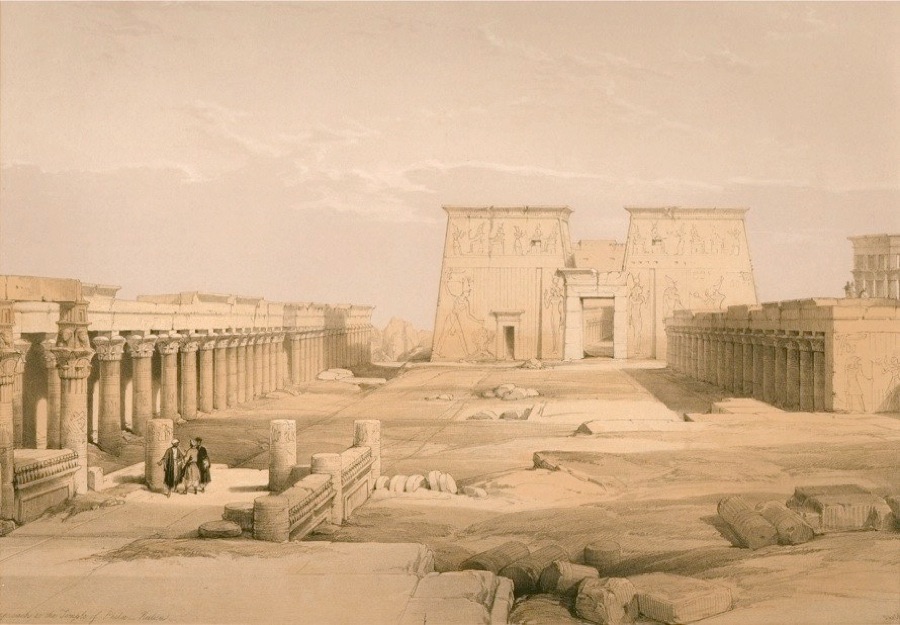GRAND APPROACH TO THE TEMPLE OF PHILÆ, NUBIA.
THIS view is taken from the southern extremity of the island, and shews the lateral colonnades, or cloisters, which bound the dromos, through which the entrance to the Temple of Isis was approached. On the left, near the foreground, the remains are seen of a small square temple, half closed by an intercolumniating mural screen. Its columns are surmounted by a very singular capital: above the ordinary and Pharaonic adaptation of the doum palm, is a quadrifrontal representation of the heads of Athor, or Isis, as in the capitals at Dendera, having an abacus, representing a small temple. Here these two members form together one lofty abacus, and, as its base spreads out towards the top of the doum palm capital, the effect is by no means inelegant, though singular.
The approach to the propylon lies through this irregular hypæthral court, or dromos: it is irregular, because, on the left, the colonnade does not extend to touch the propylon, but an open space remains between them, through which some granite rocks, of singular form, are seen. These rocks are in the middle of the Nile, and bear curious inscriptions, and are called by the Arabs, the Throne of Pharaoh: whilst, on the right, the range of columns of a corridor of greater width, masks, in its approach to the propylon, one half of one of its towers. Above the corridor the elegant Temple of Osiris, called by the Arabs, the Bed of Pharaoh, appears: it is a beautiful object, which greatly increases the picturesque character of the scene.
The huge figures on the first propylon represent, on the left, the Pharaoh Philometor, or his brother Physcon, sacrificing his enemies to Athor, or Isis; and on the right he is making an offering to Osiris. These figures of Isis are twenty feet high. The principal building is the Temple of Isis, commenced by Ptolemy Philadelphus and Arsinoë, and completed by succeeding monarchs; among whom were Euergetes I., Philometor, his brother, Euergetes II., with the two Cleopatras, and Ptolemy, the older son of Auletes, whose name is found in the area and on the towers of the propylon. Many of the sculptures on the exterior are of the latter epoch of the Roman Emperors, among whom are Augustus, Tiberias, Claudius, Domitian, Nerva, and Trajan.
The actual gateway, or pylon, in this view was erected by Nectanebo, the unfortunate Pharaoh who was dethroned by the Persians in their last invasion. This portion of the ruins of Philæ and the remains of a little temple, dedicated to Athor, near the southern extremity, whose quadrifrontal abacus might have suggested the capitals at Dendera, are the oldest of these beautiful ruins. The gateway, flanked by wings, raised by the Ptolemies already mentioned, form the first propylon to the principal temple. When this was a Christian church, the figures on the propylon were concealed with a sort of stucco, to hide all heathen and idolatrous forms; and Theodorus, who was bishop of this district, devoted the temple to the service of Christ, of which numerous indications remain; and after many centuries, during which all trace of Christianity was driven from Nubia, a record has recently been left, cut in the gateway of Nectanebo, that a Roman Catholic mission for the restoration of Christian worship had visited Philæ in 1841.
It was from the termination of the irregular dromos, which constitutes this view, that the obelisk was taken, and of which the removal was described with so much animation by Belzoni. Another obelisk remains, but behind the observer of this scene.
Roberts’s Journal Wilkinson’s Egypt and Thebes.


